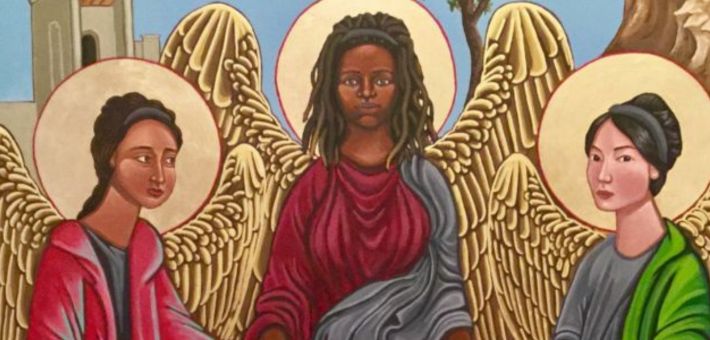Commentary on Genesis 1:1—2:4a
The writer of Genesis 1:1–2:4a presents the readers with a well-choreographed ancient cosmogony that describes the sovereignty of God over creation.
The Hebrew Bible opens with the first of two creation stories in the book of Genesis. The creation story in Genesis 1 is differentiated from the account in Genesis 2 by its liturgical style, vocabulary, and order of events, among other features. Its seven-day structure of creation has been noted by scholars as not only unique to the Hebrew Bible but also among other mentions of creation within it (for example, Psalm 104). While some readers attempt to reconcile the six-day creation story recorded in Genesis 1 with scientific evidence as proof that the biblical account is literal, such efforts miss the focus of the story as a confession of faith in the sovereign God.
When God created
Genesis 1 begins “In the beginning when God created the heavens and the earth” (New Revised Standard Version). A translation issue raised in verse 1 is whether it should be translated as an independent main clause such as, “In the beginning God created the heavens and the earth” (for example, New International Version) and thus should be read as a superscription, or as the temporal antecedent to verse 2 (or verse 3), which refers to the state of affairs prior to creation, with the conjunction “when,” God began to create as in the New Revised Standard Version translation above or “When God began to create the heavens and the earth” (Jewish Publication Society; New Revised Standard Version updated edition).
According to verse 2, the earth, as yet unformed, is a “formless void” (New Revised Standard Version), “complete chaos” (New Revised Standard Version updated edition), or as one translation put it “jumble and disorder” surrounded by an impenetrable darkness. Completing the image is a wind from God (also translated “spirit of God”). This is not some tranquil breeze, but a mighty wind sweeping over the depths of water. For a Star Wars fan like me, Genesis 1:2 reminds me of the scene in Episode II – Attack of the Clones (2002) when Jedi Master Yoda lands on planet Kamino, a watery planet surrounded by swirling, stormy oceans. The view that nothing existed before God began to create (creatio ex nihilo) belies the imagery depicted by the writer of the presence of a dark, uninhabitable, inhospitable, churning, primordial watery deep that God subdues and turns to order from chaos.
The first six days
The seven-day creation schema is noted for its skillful symmetry that divides God’s creative work into two three-day acts that culminate in God resting on the seventh day. On the first three days God establishes the realms of creation. In the same sequential order, God populates the realms according to their category. Thus, on day 1 God calls forth light from the darkness and separates the light from the darkness (Genesis 1:3–4). The light is called Day and the darkness is called Night. On day 4 God creates the sun, moon, and stars that give light to separate day from night. They serve to mark time as evenings turn to mornings, which become days, which become seasons, which become years (14–19).
On day 2 God commands a dome to appear in the middle of the waters which causes the waters above the dome to be separated from the waters below it. God called the dome Sky (6–8). On day 5 God calls forth the winged birds to fly across the dome of the sky and swarms of living creatures in the waters beneath the dome. On day 3 God commands the waters under the sky to be gathered to one side so that the dry land would appear. God named the dry land Earth and the rest of the waters Seas. The earth produced seed-bearing trees and plants upon God’s command (9––13). On day 6 God creates the land animals and humankind (24-27).
A day of rest
On day 7 having looked upon God’s handiwork and declaring that it was indeed very good, God ceased from working and blessed the day. Thus, what God began on day 1 reaches its conclusion in Genesis 2:1. The verb “to cease” or “to rest” in Hebrew is shavat. This is distinct from the noun shabbat or sabbath. The image of God needing to rest after creation may seem incompatible with our ideas of needing to rest from physical exertion but for a God who creates by divine fiat, to rest is to declare that God has completely subdued chaos and rules over all creation. Thus, God blessed the creatures of the sky and sea (verse 22), God blessed humankind (26–27), and God blessed the seventh day after resting from all work that God had done (2:1) and sanctified it.
The act of sanctifying or consecrating the seventh day is to “set apart” this day from ordinary space and time and to place it within sacred space and time. Despite our inclination to observe the Sabbath as a day of worship in synagogue or church, the fourth commandment in the Decalogue does not instruct Israel to build an altar and worship God. Instead, it is an invitation to imitate God, as those who are made in God’s image and likeness, in setting one day aside as holy and to rest (Exodus 20:8–11) and remember (Deuteronomy 5:12–15) God as sovereign over the created order. Of course, the etiology of the Sabbath in Exodus 20 harkens back to Genesis 2:1–4a. The creation account concludes where our creation account began with a summary notice of all that God had created as now completed.
The God portrayed in Genesis 1:1–2:4a is transcendent and far from reach but in a world of much turbulence and chaos, it is good to worship a god who is sovereign, blessed us, and declared that we are good.


June 4, 2023